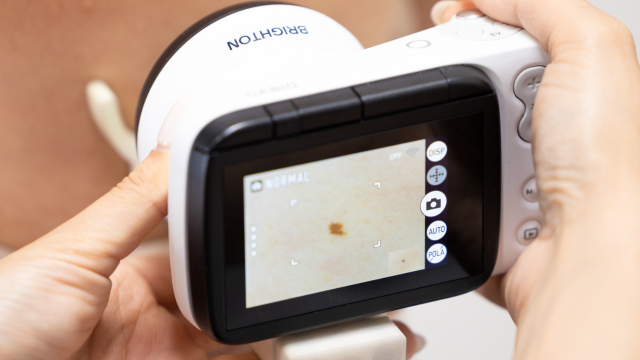
This article is sponsored by MoleMap.
As Australians, we’ve been raised to slap on a hat and apply factor 50 SPF when outside, (‘No Hat, No Play’ will forever be on my conscience). With Australia having one of the highest rates of melanoma in the world, it’s incredibly important to look after our skin — especially as we head towards the warmer months.
Preventative measures such as skin checks and full body skin mapping are becoming increasingly popular as we learn more about the impacts of skin cancer. But, what’s the difference between the two? And how do you know which one you need?
To learn more, we spoke with Dr Franz Strydom, the Chief Medical Officer at MoleMap Australia & New Zealand and Kirsten Harris, MoleMap’s GM of Marketing.
What is a skin check?
According to Dr Franz, a skin check is a study to look for any suspicious lesions currently on the skin.
“It is important to record and photograph areas or lesions of concern to monitor or confirm a possible diagnosis.”
At MoleMap, during a Skin Check, you’ll undergo a full-body examination by a melanographer from head to toe, including under your nails and behind your ears. Any suspicious-looking moles or spots will be imaged and sent to a dermatologist for diagnosis.
You will then receive a diagnostic report within a few days indicating whether further action is required. You can receive treatment either at a MoleMap treatment clinic or you can be referred to your GP. MoleMap will also provide a recommendation on when you next need to visit, and advise on how to continue to self-check at home in the meantime.
What is a mole map?
During a Full Body MoleMap, the team images the entire skin’s surface using total body photography as a long-term record of the skin.
According to Kirsten Harris, during the appointment, the patient’s risk history is taken, and then after changing into a modesty gown, a melanographer will begin the process of checking the skin from head to toe.
“They’ll check the skin carefully, pausing at each spot that needs monitoring or diagnosis to take dermoscopic (under the skin) images and plot these to an avatar so they can be located accurately in the future.” These images are then sent to a dermatologist for diagnosis.
If you have any history of lesions such as itchiness or bleeding, they can also be recorded for diagnosis. As well as being sent to the dermatologist, the images taken will be uploaded to your individual portal so you can refer to them during your own at-home self-monitoring and they will be re-imaged at your future MoleMap appointments to look for tiny subtle changes.
Your diagnostic report will also be uploaded to your portal, and to your nominated GP if required.
How often do I need to get my skin checked?
Dr Franz shares that how often you get your skin checked will depend on many factors, including your individual risk of developing skin cancer.
“For most people, annual checks are recommended,” Dr Franz notes.
A yearly check is a great way to stay on top of your skin health and be able to enjoy the warmer months worry-free.
When should people be concerned about a change in their skin?
Kirsten recommends checking your skin regularly for spots “which are new, different to the other spots, changing or are symptomatic (itchy, sore, bleeds easily).”
“If you get to know your own skin, you are more likely to spot anything that is new or different. And act quickly if you notice anything changing.”
A good note to remember is that if a mole is new or changing, you should seek advice and have it checked. There’s no harm in getting professional advice on a change in your body.
Is there ever a “safe” amount of sunlight?
As the warmer months approach, it can be tempting to spend hours outdoors. But is there ever a “safe” amount of sunlight?
“We do need sunlight for normal physiological functioning such as making Vitamin D and it also plays a huge role in our psyche,” says Dr Franz. “There needs to be a balance between the risk and benefit of sun exposure.”
It goes without saying that we should avoid sunburn at all costs.
“Limited exposure to mild sunlight (mornings and afternoons) is great. Always protect yourself from intense or longer duration of exposure by covering up with hats and sun-protective clothing. Then, use sunscreen to protect the areas you can’t cover up and remember to reapply sunscreen.”
It’s the basics we were taught in primary school, but a reminder before the summer months can’t hurt. Stay safe this season, folks.
Head to MoleMap for more information and to book an appointment.

Leave a Reply
You must be logged in to post a comment.